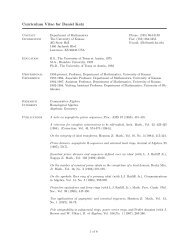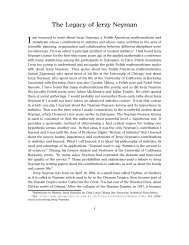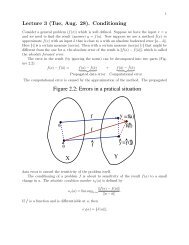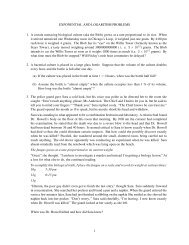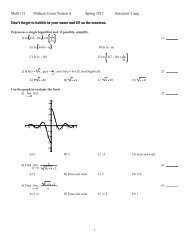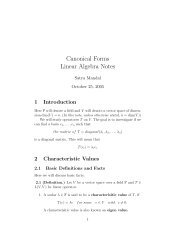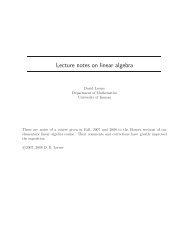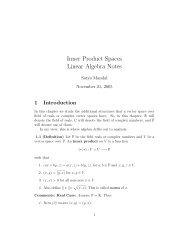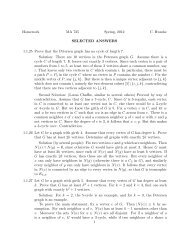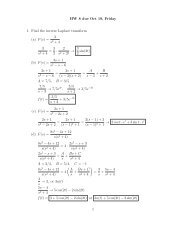9 The derivative as a linear transformation
9 The derivative as a linear transformation
9 The derivative as a linear transformation
Create successful ePaper yourself
Turn your PDF publications into a flip-book with our unique Google optimized e-Paper software.
9 <strong>The</strong> <strong>derivative</strong> <strong>as</strong> a <strong>linear</strong> <strong>transformation</strong><br />
9.1 Redefining the <strong>derivative</strong><br />
Matrices appear in many different contexts in mathematics, not just when we need to solve<br />
a system of <strong>linear</strong> equations. An important instance is <strong>linear</strong> approximation. Recall from<br />
your calculus course that a differentiable function f can be expanded about any point a in<br />
its domain using Taylor’s theorem. We can write<br />
f(x) = f(a) + f ′ (a)(x − a) + f ′′ (c)<br />
(x − a)<br />
2!<br />
2 ,<br />
where c is some point between x and a. <strong>The</strong> remainder term f ′′ (c)<br />
2! (x − a)2 is the “error”<br />
made by using the <strong>linear</strong> approximation to f at x = a,<br />
f(x) ≈ f(a) + f ′ (a)(x − a).<br />
That is, f(x) minus the approximation is exactly equal to the error (remainder) term. In<br />
fact, we can write Taylor’s theorem in the more suggestive form<br />
f(x) = f(a) + f ′ (a)(x − a) + ɛ(x, a),<br />
where the remainder term h<strong>as</strong> now been renamed the error term ɛ(x, a) and h<strong>as</strong> the im-<br />
portant property<br />
ɛ(x, a)<br />
lim<br />
x→a x − a<br />
(<strong>The</strong> existence of this limit is another way of saying that the error term “looks like” (x−a) 2 .)<br />
This observation gives us an alternative (and in fact, much better) definition of the <strong>derivative</strong>:<br />
Definition: <strong>The</strong> real-valued function f is said to be differentiable at x = a if there exists<br />
a number A and a function ɛ(x, a) such that<br />
where<br />
= 0.<br />
f(x) = f(a) + A(x − a) + ɛ(x, a),<br />
lim<br />
x→a<br />
ɛ(x, a)<br />
x − a<br />
1<br />
= 0.
Remark: the error term ɛ = f ′′ (c)<br />
2 (x − a) 2 clearly depends on a, and it depends on x <strong>as</strong> well<br />
since the number c varies with x.<br />
<strong>The</strong>orem: This is equivalent to the usual calculus definition.<br />
Proof: If the new definition holds, then if we compute f ′ (x) by the usual definition, we find<br />
lim<br />
x→a<br />
f(x) − f(a)<br />
x − a<br />
= A + lim<br />
x→a<br />
ɛ(x, a)<br />
x − a<br />
= A + 0 = A,<br />
and A = f ′ (a) according to the standard definition. Conversely, if the standard defini-<br />
tion of differentiability holds, then we can define ɛ(x, a) to be the error made in the <strong>linear</strong><br />
approximation:<br />
<strong>The</strong>n<br />
ɛ(x, a)<br />
lim<br />
x→a x − a<br />
ɛ(x, a) = f(x) − f(a) − f ′ (a)(x − a).<br />
= lim<br />
x→a<br />
f(x) − f(a)<br />
x − a<br />
so f can be written in the new form, with A = f ′ (a).<br />
− f ′ (a) = f ′ (a) − f ′ (a) = 0,<br />
Example: Let f(x) = 4 + 2x − x 2 , and let a = 2. So f(a) = f(2) = 4, and f ′ (a) = f ′ (2) =<br />
2 − 2a = −2.. Now subtract f(2) + f ′ (2)(x − 2) from f(x) to get<br />
4 + 2x − x 2 − (4 − 2(x − 2)) = −4 + 4x − x 2 = −(x − 2) 2 .<br />
This is the error term, which is quadratic in x−2, <strong>as</strong> advertised. So 8−2x(= f(2)+f ′ (2)(x−<br />
2)) is the correct <strong>linear</strong> approximation to f at x = 2.<br />
Suppose we try some other <strong>linear</strong> approximation - for example, we could try f(2)−4(x−2) =<br />
12 − 4x. Subtracting this from f(x) gives −8 + 6x − x 2 = −2(x − 2) − (x − 2) 2 , which is our<br />
new error term. But this won’t work, since<br />
−2(x − 2) − (x − 2)<br />
lim<br />
x→2<br />
2<br />
(x − 2)<br />
= −2,<br />
which is clearly not 0. <strong>The</strong> only “<strong>linear</strong> approximation” that leaves a quadratic remainder<br />
<strong>as</strong> the error term is the one formed in the usual way, using the <strong>derivative</strong>.<br />
2
Exercise: Interpret this geometrically in terms of the slope of various lines p<strong>as</strong>sing through<br />
the point (2, f(2)).<br />
9.2 Generalization to higher dimensions<br />
Our new definition of <strong>derivative</strong> is the one which generalizes to higher dimensions. We start<br />
with an<br />
Example: Consider a function from R 2 to R 2 , say<br />
⎛<br />
f(x) = f ⎝ x<br />
⎞ ⎛ ⎞ ⎛<br />
u(x, y)<br />
⎠ = ⎝ ⎠ = ⎝<br />
y v(x, y)<br />
2 + x + 4y + 4x2 + 5xy − y2 1 − x + 2y − 2x2 + 3xy + y2 ⎞<br />
⎠<br />
By inspection, <strong>as</strong> it were, we can separate the right hand side into three parts. We have<br />
⎛<br />
f(0) = ⎝ 2<br />
⎞<br />
⎠<br />
1<br />
and the <strong>linear</strong> part of f is the vector<br />
⎛<br />
⎝<br />
x + 4y<br />
−x + 2y<br />
⎞<br />
⎠ ,<br />
which can be written in matrix form <strong>as</strong><br />
⎛ ⎞ ⎛<br />
Ax = ⎝<br />
1 4<br />
⎠ ⎝<br />
−1 2<br />
x<br />
⎞<br />
⎠ .<br />
y<br />
By analogy with the one-dimensional c<strong>as</strong>e, we might guess that<br />
where A is the matrix<br />
f(x) = f(0) + Ax + an error term of order 2 in x, y.<br />
A =<br />
⎛<br />
⎜<br />
⎝<br />
∂u<br />
∂x<br />
∂v<br />
∂x<br />
∂u<br />
⎞<br />
∂y<br />
∂v<br />
∂y<br />
⎟<br />
⎠ (0, 0).<br />
3
And this suggests the following<br />
Definition: A function f : R n → R m is said to be differentiable at the point x = a ∈ R n if<br />
there exists an m × n matrix A and a function ɛ(x, a) such that<br />
where<br />
f(x) = f(a) + A(x − a) + ɛ(x, a),<br />
ɛ(x, a)<br />
lim<br />
x→a ||x − a||<br />
= 0.<br />
<strong>The</strong> matrix A is called the <strong>derivative</strong> of f at x = a, and is denoted by Df(a).<br />
Generalizing the one-dimensional c<strong>as</strong>e, it can be shown that if<br />
⎛ ⎞<br />
⎜<br />
f(x) = ⎜<br />
⎝<br />
u1(x)<br />
.<br />
um(x)<br />
⎟<br />
⎠ ,<br />
is differentiable at x = a, then the <strong>derivative</strong> of f is given by the m × n matrix of partial<br />
<strong>derivative</strong>s<br />
⎛<br />
⎜<br />
Df(a) = ⎜<br />
⎝<br />
∂u1<br />
∂x1<br />
.<br />
∂um<br />
∂x1<br />
· · ·<br />
.<br />
· · ·<br />
∂u1<br />
∂xn<br />
.<br />
∂um<br />
∂xn<br />
⎞<br />
⎟<br />
⎟(a).<br />
⎠<br />
m×n<br />
Conversely, if all the indicated partial <strong>derivative</strong>s exist and are continuous at x = a, then<br />
the approximation<br />
is accurate to the second order in x − a.<br />
f(x) ≈ f(a) + Df(a)(x − a)<br />
Exercise: Find the <strong>derivative</strong> of the function f : R2 → R3 at a = (1, 2) t , where<br />
⎛<br />
⎜<br />
f(x) = ⎜<br />
⎝<br />
(x + y) 3<br />
x2y3 ⎞<br />
y/x<br />
⎟<br />
⎠<br />
4





